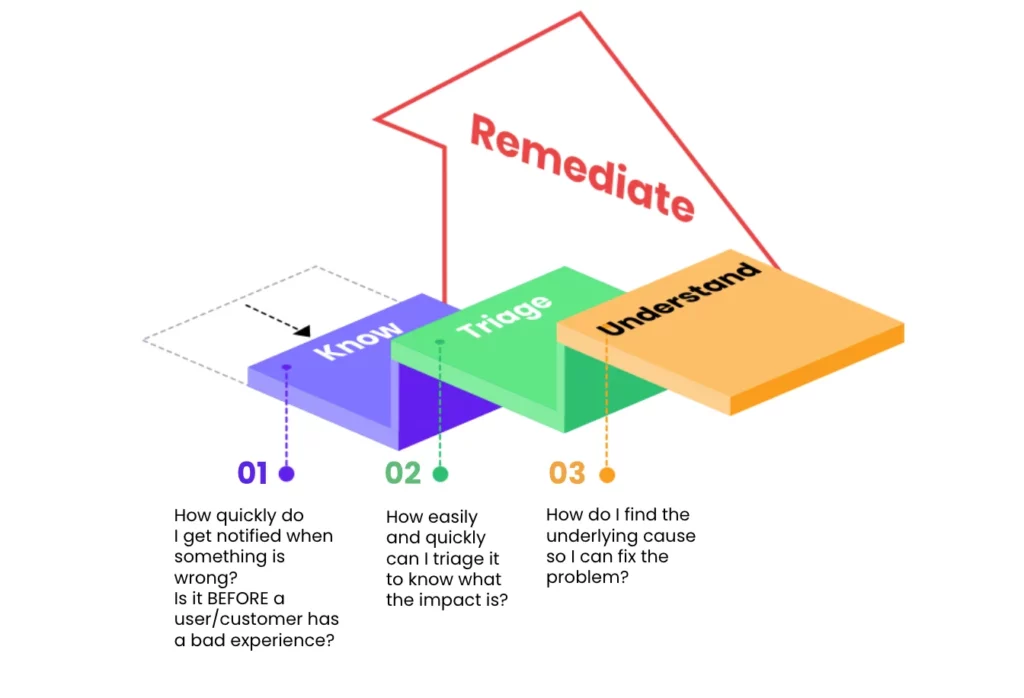What are the three pillars of observability?
What is the meaning of observability? For some, observability has been defined as a collection of distinct data types known as the three pillars—logs, metrics, and distributed traces. While these are all critical inputs to observability, they are not observability solutions in and of themselves. Rather than focusing on outcome, the siloed “three pillars of observability” approach to observability is overly focused on technical instrumentation and underlying data formats.
- Logs: How do logs fit into observability? Logs describe discrete events and transactions within a system. They consist of messages generated by your application over a precise period of time that can tell you a story about what’s happening.
- Metrics: Metrics consist of time-series data that describes a measurement of resource utilization or behavior. They are useful because they provide insights into the behavior and health of a system, especially when aggregated.
- Distributed Traces: What are distributed traces in observability? Traces use unique IDs to track down individual requests as they hop from one service to another. They can show you how a request travels from one end to the other.
Observability is more than the three pillars
Although emitting all the data types in the three pillars of observability is important, these inputs alone can never guarantee better outcomes in cloud-native environments. For example, if a system emits logs, metrics, and distributed traces there is no guarantee that you will get notified about an issue in a timely manner, nor is there a guarantee you can triage issues quickly.
What’s more, many companies find little correlation between the amount of observability data produced and the value derived from this data. This is to say, more logs or metrics don’t equate to more value, even though they almost always equate to increased costs.
While the three pillars of observability outline important data functions, true outcome-based observability comes from zeroing in on the three phases of observability – referred to as “know, triage, and understand” – because teams are able to derive maximum value from their data on the way to rapid issue resolution.
The what and why of observability
Observability is both a practice (or process) and describes the property (or state) of a service. Like DevOps, observability is a core competency of distributed systems engineering. It is the practice that cloud-native developers do on a daily basis in increasingly complex systems. Observability is also a property of a system–whether or not it produces data that can be used to answer any question that a developer asks of it. It is much easier to maintain and manage an observable system than a non-observable one.
Rather than focus on observability in terms of the three pillars, engineering and SRE leaders in cloud-native environments should think about the three phases. Why? Because the three phases of observability do more to answer critical questions about operating the code and systems they’ve built. Also a property of newer systems, observability solutions produce data that answers developers’ questions in real or near-real time.
What challenges does observability address?
The need to introspect and understand systems and services is not new – many of the basic goals of observability have been in practice for decades. What’s changed, and where the three phases of observability come in, is driven by the fundamentally different nature of operating modern applications and infrastructure.
Cloud-native applications running on containers and microservices have a completely different architecture and are designed to be more scalable, reliable, and flexible than legacy apps. Cloud-hosted monitoring and application performance monitoring (APM) were born in a pre-cloud-native world – one that had very different underlying assumptions. Cloud-native has forced organizations to revisit how they perform monitoring and observility because:
- Data is growing in scale and cardinality. Cloud-native environments emit a massive amount of monitoring data — somewhere between 10x and 100x more than traditional VM-based environments.
- Systems are more flexible and ephemeral. Both the usage patterns and retention requirements are vastly different from what they were pre-cloud-native.
- Services and systems have greater interdependencies. Breaking services down into microservices leads to more complex dependencies that engineers must understand in order to troubleshoot problems. This also results in a greater need to correlate and connect infrastructure to applications to business metrics.
All of this has led to an explosion in complexity that makes it nearly impossible to reliably and efficiently operate cloud-native services without either dramatically increasing overhead, or finding a new approach. For example, the three phases of observability is an alternate approach to the “three pillars of observability” that is focused on the outcomes instead of the inputs.
How metrics, distributed traces, and logs work together
While each of the three pillars—logs, metrics, and distributed traces—provides unique insights, their true power lies in how they work together. Metrics offer a high-level view of system performance, helping teams quickly spot anomalies or bottlenecks. Logs deliver context-rich information, allowing engineers to drill down into the details of what happened at a specific point in time.
Distributed traces, on the other hand, map the flow of requests across services, connecting the dots between different parts of a distributed system. Together, they provide a comprehensive view, helping teams not only detect but also diagnose and resolve issues efficiently. This synergy enables faster root cause analysis and smoother operational workflows, particularly in complex cloud-native environments.
Better outcomes: The three phases of observability explained
The goal of each of the three phases of observability is to minimize negative impacts on customer or employee experience. DevOps teams do that by quickly finding the information they need to fix problems introduced in code fast—even before understanding a root cause. It’s important to note that remediation isn’t always the complete elimination of a challenge but rather the restoring of services to availability and performance levels that customers and employees have come to expect. Each phase maps to answering one of the three critical questions we believe is required to achieve great observability.
These are the three key phases (and tools required) to achieve great observability:
- Know: Recognize there’s a problem
You can’t fix an unknown problem. That’s why remediation starts with knowing there’s an issue in the first place—ideally before your customer does. Adding the technology (or observability solution) perspective, the fastest path to recognizing a problem is an actionable alert with correlated metrics, distributed traces, and potentially even logs.
Companies such as Chronosphere offer an observability platform that focuses on the outcome—helping you find problems fast. For example, Chronosphere customers have reduced their time to detection by up to 3x and have advanced capabilities to ensure that every alert is actionable.
Introducing changes to a system is the largest source of production issues, so the ability to quickly connect the problem to the change is key. With a complete observability platform, team members can go straight from an alert to the remediation – often rolling back the latest deploy. Then they can perform root cause analysis without the ticking clock of customer expectations.
- Triage: Stop the problem from creating additional negative outcomes
Not all issues can be immediately remediated from the alert stage, many will have to go to triage. Triage is preliminary assessment of the scope of a problem, and indicates what is most important. This step is imperative because it helps to determine the urgency level for larger remediation efforts. Triage answers questions such as:
- How many customers are impacted and to what degree?
- Who is the best internal resource to help and are they available?
Observability platforms such as Chronosphere allow engineers to pivot the data and quickly shine a spotlight on contextualized data to diagnose issues. This involves directly linking to dashboards that show not only the source of the alert, but related and relevant contextual data. Moreover, engineers can rapidly manipulate the data to further isolate the problem using high cardinality pivots. That way, teams can quickly determine a best-course of action, which may be the difference between waking up a large team in the middle of the night to debug an issue, or waiting until the morning because the impact and severity is lower.
- Understand: Dive into the Root Cause of the Problem
After discovery and triaging of the problem, teams need to be able to shift quickly to finding out where and how the issue started to prevent it from happening again. Everyone can speculate, but correlated distributed traces, logs, metrics and dashboards will give the data needed for a post-mortem to surface dependencies and what really went wrong at the most basic level.
Companies such as Chronosphere have an observability platform that gives engineers a direct line of sight into problem culprits by linking metrics and traces. Easy understanding of service dependencies comes from identifying the direct upstream and downstream dependencies of the service experiencing an active issue. Chronosphere is a single solution that lets teams efficiently navigate between distributed traces and metrics to find trends and outliers so people can solve complex issues.
Additionally, Chronosphere’s observability platform provides insights by surfacing probable causes in alert notifications or during triage using dashboards to reduce time to root causes that can help fix underlying problems to eliminate the recurrence of incidents.
From knowing to triaging to understanding, teams that choose the Chronosphere platform benefit from observability simplified.
True outcome-based observability comes from zeroing in on the three phases of observability – know, triage, and understand.
Teams deserve more than the three pillars of observability
The primary goal is to get from the problem-starting to problem-resolution as quickly as possible. The technical inputs, or three pillars of observability, are helpful enablement tools but they don’t improve outcomes. Boost your outcome success with the three phases of observability, considering first the steps of know > triage > understand.
Great observability can lead to competitive advantage, world-class customer experiences, faster innovation, and happier developers. But organizations can’t achieve great observability by just focusing on the input and data (three pillars of observability). By focusing on the three phases and the outcomes outlined here, teams can achieve the promise of great observability.






